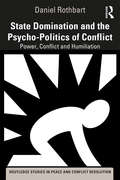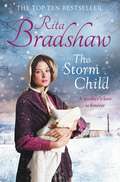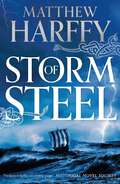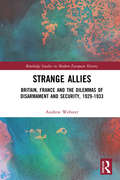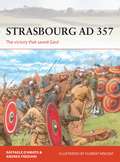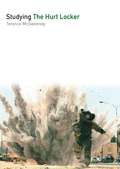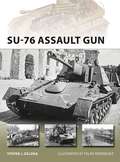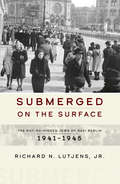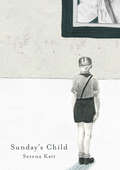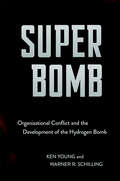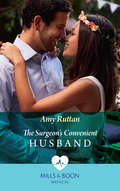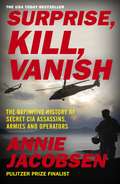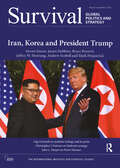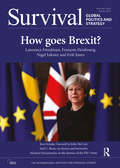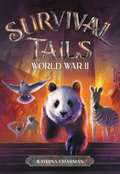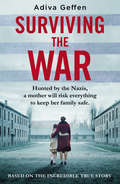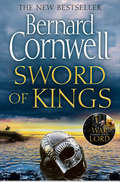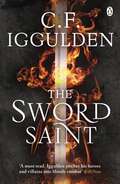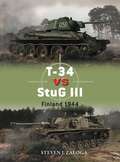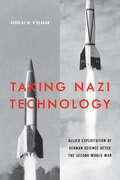- Table View
- List View
State Domination and the Psycho-Politics of Conflict: Power, Conflict and Humiliation (Routledge Studies in Peace and Conflict Resolution)
by Daniel RothbartThis book offers a detailed study of the psycho-politics of governmental manipulation, in which a vulnerable population is disciplined by contorting their sense of self-worth. In many conflict settings, a nation’s government exerts its dominance over a marginalized population group through laws, policies and practices that foster stark inequality. This book shows how such domination comes in the form of systems of humiliation orchestrated by governmental forces. This thesis draws upon recent findings in social psychology, conflict analysis, and political sociology, with case studies of governmental directives, verdicts, policies, decisions and norms that, when enforced, foster debasement, disgrace or denigration. One case centers on the US immigration laws that target vulnerable population groups, while another focuses on the ethnic discrimination of the central government of Sudan against the Sudanese Africans. The book’s conclusion focuses on compassion-motivated practices that represent a counter-force to government-sponsored strategies of systemic humiliation. These are practices for building peace by professionals and non-professionals as a positive response to protracted violence. This book will be of much interest to students of peace and conflict studies, sociology, psychology, ethics, philosophy and international relations.
The Storm Child: The perfect Winter read from the top ten bestseller
by Rita BradshawFrom the top-ten bestselling author of One Snowy Night, Rita Bradshaw, comes The Storm Child, a sweeping family saga set during the run up to WW2 in the north-east of England.It’s mid-winter, and in the throes of a fierce blizzard Elsie Redfern and her husband discover an unknown girl in their hay barn about to give birth. After the young mother dies, Elsie takes the infant in and raises her as her own daughter, her precious storm child.Gina grows into a beautiful little girl, but her safe haven turns out to be anything but. Torn away from her home and family, the child finds herself in a nightmare from which there’s no waking, but despite her misery and bewilderment, Gina’s determined to survive.Years pass. With womanhood comes the Second World War, along with more heartbreak, grief and betrayal. Then, a new but dangerous love beckons; can Gina ever escape the dark legacy of the storm child?
Storm of Steel (The Bernicia Chronicles #6)
by Matthew HarffyAD 643. Anglo-Saxon Britain. A gripping, action-packed historical thriller and the sixth instalment in the Bernicia Chronicles. Heading south to lands he once considered his home, Beobrand is plunged into a dark world of piracy and slavery when an old friend enlists his help to recover a kidnapped girl.Embarking onto the wind-tossed seas, Beobrand pursues his quarry with single-minded tenacity. But the Whale Road is never calm and his journey is beset with storms, betrayal and violence.As the winds of his wyrd blow him ever further from what he knows, will Beobrand find victory on his quest or has his luck finally abandoned him?Praise for Matthew Harffy: 'Nothing less than superb... The tale is fast paced and violence lurks on every page' Historical Novel Society'Beobrand is the warrior to follow' David Gilman'A tale that rings like sword song in the reader's mind' Giles Kristian'Historical fiction doesn't get much better than this' Angus Donald'A brilliant characterization of a difficult hero in a dangerous time. Excellent!' Christian Cameron'A terrific novel. It illuminates the Dark Ages like a bolt of lightning' Toby Clements'Battles, treachery, revenge and a healthy dose of Dark Age adventure' Simon Turney'Matthew Harffy tells a great story' Joanna Hickson'Harffy's writing just gets better and better... He is really proving himself the rightful heir to Gemmell's crown' Jemahl Evans'Harffy has a real winner on his hands... A genuinely superb novel' Steven McKay'A breathtaking novel that sweeps the reader into a dark and dangerous world' Paul Fraser Collard
Strange Allies: Britain, France and the Dilemmas of Disarmament and Security, 1929-1933 (Routledge Studies in Modern European History)
by Andrew WebsterStrange Allies examines three intersecting themes of fundamental importance to the international history of the period between the two world wars. First, and most broadly, it is a study of the international history of the pivotal ‘hinge years’, running from the onset of the Depression in late 1929 to the Nazi capture of power in Germany in early 1933. The second theme is the strategic relationship between Britain and France, the critical dynamic in the management of global and European international relations during this time of great fluidity and uncertainty. The most contentious and intractable issue that divided the two countries was the pursuit of international disarmament, which forms the third theme of the book. Strange Allies is based upon extensive research in British and French archives, as well as in the archives of the League of Nations in Geneva. The book’s focus on 1929–31 in particular makes a major contribution to the international history of the interwar period by re-examining the security and strategic policies of the second Labour government in Britain and of foreign minister Aristide Briand in the post-Locarno years in France. For 1931–33, the book looks at the impact of the great financial and economic crisis of 1931 on security and disarmament planning in Britain and France. It then considers the impact of the Anglo-French relationship on the instability of Europe and on the failure of the World Disarmament Conference. This book is the first detailed study of the Anglo-French relationship during a critical period which saw a reshaping of the boundaries of global security. Although the Anglo-French alliance is rightly seen to be pivotal to both the initial phase of implementing the Versailles settlement of 1919 and the efforts to contain Hitler and protect Europe after 1936, Strange Allies demonstrates the degree to which these states’ conflicting views of security were central to international relations in the years leading up to Hitler’s accession to power.
Strange Allies: Britain, France and the Dilemmas of Disarmament and Security, 1929-1933 (Routledge Studies in Modern European History)
by Andrew WebsterStrange Allies examines three intersecting themes of fundamental importance to the international history of the period between the two world wars. First, and most broadly, it is a study of the international history of the pivotal ‘hinge years’, running from the onset of the Depression in late 1929 to the Nazi capture of power in Germany in early 1933. The second theme is the strategic relationship between Britain and France, the critical dynamic in the management of global and European international relations during this time of great fluidity and uncertainty. The most contentious and intractable issue that divided the two countries was the pursuit of international disarmament, which forms the third theme of the book. Strange Allies is based upon extensive research in British and French archives, as well as in the archives of the League of Nations in Geneva. The book’s focus on 1929–31 in particular makes a major contribution to the international history of the interwar period by re-examining the security and strategic policies of the second Labour government in Britain and of foreign minister Aristide Briand in the post-Locarno years in France. For 1931–33, the book looks at the impact of the great financial and economic crisis of 1931 on security and disarmament planning in Britain and France. It then considers the impact of the Anglo-French relationship on the instability of Europe and on the failure of the World Disarmament Conference. This book is the first detailed study of the Anglo-French relationship during a critical period which saw a reshaping of the boundaries of global security. Although the Anglo-French alliance is rightly seen to be pivotal to both the initial phase of implementing the Versailles settlement of 1919 and the efforts to contain Hitler and protect Europe after 1936, Strange Allies demonstrates the degree to which these states’ conflicting views of security were central to international relations in the years leading up to Hitler’s accession to power.
Strasbourg AD 357: The victory that saved Gaul (Campaign #336)
by Raffaele D’Amato Andrea FredianiCivil war in the Western Roman Empire between AD 350–53 had left the frontiers weakly defended, and the major German confederations along the Rhine – the Franks and Alemanni – took advantage of the situation to cross the river, destroy the Roman fortifications along it and occupy parts of Roman Gaul. In 355, the Emperor Constantius appointed his 23-year-old cousin Julian as his Caesar in the provinces of Gaul with command of all troops in the region. Having recaptured the city of Cologne, Julian planned to trap the Alemanni in a pincer movement, but when the larger half of his army was forced into retreat, he was left facing a much larger German force outside the walls of the city of Strasbourg. This new study relates the events of this epic battle as the experience and training of the Roman forces prevailed in the face of overwhelming German numbers.
The Street of Broken Dreams: Winner of Romantic Saga of the Year 2020 (Banbury Street #2)
by Tania CrosseWinner of Romantic Saga of the Year 2020. Summer 1945. The nation rejoices as the Second World War comes to an end but Banbury Street matriarch, Eva Parker, foresees trouble ahead. Whilst her daughter, Mildred, awaits the return of her fiancé from overseas duty, doubts begin to seep into her mind about how little she knows of the man she has promised to marry. Or are her affections being drawn elsewhere? Meanwhile, new neighbour, dancer Cissie Cresswell, hides a terrible secret. The end of the conflict will bring her no release from the horrific night that destroyed her life. Can she ever find her way back? Under Eva's stalwart care, can the two young women unite to face the doubt and uncertainty of the future? In 2020, this poignant story of love and war won the RNA award for Best Romantic Saga. It is perfect for fans of Elaine Everest and Daisy Styles. What readers are saying about The Street of Broken Dreams: 'With warmth radiating from every page, The Street of Broken Dreams is an atmospheric story of love and hope' Jennifer Wells. 'Gripping, gutsy and absolutely unputdownable... A must-read for saga fans everywhere' Julie, NetGalley. 'I read this book in one sitting and I would highly recommend it' Stephanie, NetGalley.
Studying The Hurt Locker (Studying Films)
by Terence McSweeneyIn this vibrant and dynamic book-length study drawing on a broad tapestry of research, Terence McSweeney offers an exploration of The Hurt Locker (2009), its stylistic and narrative devices, its cultural impact, its reception, and its relationship to the genre of the war film. McSweeney places the film in a richly textured historical, political, and industrial context, arguing that The Hurt Locker is part of a long tradition of films about American wars that play a considerable role in how audiences come to understand the conflicts that they depict. Thus, films about a nation’s wars are never “only a movie” but rather should be considered a cultural battleground themselves on which a war of representation is waged.
SU-76 Assault Gun (New Vanguard #270)
by Steven J. ZalogaThe SU-76 assault gun was the second most widely manufactured Soviet armoured fighting vehicle of World War II, out-numbered only by the legendary T-34. Inspired in part by the German Marder series of tank destroyers, Soviet designers realized that the chassis of the obsolete T-70 light tank could be adapted to a much more substantial gun if it was placed in a fixed casemate rather than in a turret. This led to the design of the SU-76, which saw its combat debut at Kursk in the summer of 1943. The SU-76 was deployed primarily as an infantry direct support weapon, becoming the infantry tank of the Red Infantry, much as the StuG III became the infantry tank of the German infantry. Featuring full colour artwork and written by an expert on tank warfare during World War II, this fascinating study describes one of the Soviet Union's most important armoured vehicles during its struggle with Nazi Germany.
Submerged on the Surface: The Not-So-Hidden Jews of Nazi Berlin, 1941–1945
by Richard N. Lutjens Jr.Between 1941 and 1945, thousands of German Jews, in fear for their lives, made the choice to flee their impending deportations and live submerged in the shadows of the Nazi capital. Drawing on a wealth of archival evidence and interviews with survivors, this book reconstructs the daily lives of Jews who stayed in Berlin during the war years. Contrary to the received wisdom that “hidden” Jews stayed in attics and cellars and had minimal contact with the outside world, the author reveals a cohort of remarkable individuals who were constantly on the move and actively fought to ensure their own survival.
Sunday's Child
by Serena KattSerena Katt’s grandfather, whom she knew as Opa, was a ‘Sunday’s Child’, one of the lucky ones for whom everything always went right. Opa left a brief account of his childhood and teenage years, but it is opaque, a story of prizes won and boyish adventures. In Sunday’s Child, Serena Katt interrogates Opa’s version of his life. Was it really so innocent? Did he really not know what the Nazis were doing? He joined the Hitler Youth at the age of ten, swearing an oath of loyalty to the Fuhrer. From then on the games he played were actually military training, designed to produce a ‘new German youth … violent, domineering, unafraid, cruel … which the world will fear’. At seventeen, in the final desperate days of the war, he is called up but his luck holds. He is sent home and thus survives the war.Sunday’s Child marks the debut of a remarkable graphic novelist. Serena Katt’s book is powerful, eloquent and moving, and her drawing is superb.
Super Bomb: Organizational Conflict and the Development of the Hydrogen Bomb (Cornell Studies in Security Affairs)
by Ken Young Warner R. SchillingSuper Bomb unveils the story of the events leading up to President Harry S. Truman's 1950 decision to develop a "super," or hydrogen, bomb. That fateful decision and its immediate consequences are detailed in a diverse and complete account built on newly released archives and previously hidden contemporaneous interviews with more than sixty political, military, and scientific figures who were involved in the decision. Ken Young and Warner R. Schilling present the expectations, hopes, and fears of the key individuals who lobbied for and against developing the H-bomb. They portray the conflicts that arose over the H-bomb as rooted in the distinct interests of the Atomic Energy Commission, the Los Alamos laboratory, the Pentagon and State Department, the Congress, and the White House. But as they clearly show, once Truman made his decision in 1950, resistance to the H-bomb opportunistically shifted to new debates about the development of tactical nuclear weapons, continental air defense, and other aspects of nuclear weapons policy. What Super Bomb reveals is that in many ways the H-bomb struggle was a proxy battle over the morality and effectiveness of strategic bombardment and the role and doctrine of the US Strategic Air Command.
The Surgeon's Convenient Husband: The Sheikh Doc's Marriage Bargain / The Surgeon's Convenient Husband (Mills And Boon Medical Ser. #Vol. 1030)
by Amy RuttanSurprise reunion… …with her husband!
Surprise, Kill, Vanish: The Definitive History of Secret CIA Assassins, Armies and Operators
by Annie JacobsenSince 1947, domestic and foreign assassinations have been executed under the CIA-led covert action operations team. Before that time, responsibility for taking out America's enemies abroad was even more shrouded in mystery. Despite Hollywood notions of last-minute rogue-operations and external secret hires, covert action is actually a cog in a colossal foreign policy machine, moving through, among others, the Bureau of Intelligence and Research, the House and Senate Select Committees. At the end of the day, it is the President, not the CIA, who is singularly in charge.When diplomacy fails and overt military action is not feasible, the President often calls on the Special Activities Division, the most secretive and lowest-profile branch of the CIA. It is this paramilitary team that undertakes dramatic and little-known assignments: hostage rescues, sabotage, and, of course, assassinations. For the first time, Pulitzer Prize finalist and New York Times bestselling author Annie Jacobsen takes us deep inside this top-secret history. With unparalleled access to former operatives, ambassadors, and even past directors of the Secret Service and CIA operations, Jacobsen reveals the inner workings of these teams, and just how far a U.S. president may go, covertly but lawfully, to pursue the nation's interests.
Survival 60.4
by The International The International Institute for Strategic Studies (IISS),Survival, the bi-monthly publication from The International Institute for Strategic Studies, is a leading forum for analysis and debate of international and strategic affairs. With a diverse range of authors, thoughtful reviews and review essays, Survival is scholarly in depth while vivid, well-written and policy-relevant in approach. Shaped by its editors to be both timely and forward-thinking, the publication encourages writers to challenge conventional wisdom and bring fresh, often controversial, perspectives to bear on the strategic issues of the moment.
Survival 60.4
by The International Institute for Strategic StudiesSurvival, the bi-monthly publication from The International Institute for Strategic Studies, is a leading forum for analysis and debate of international and strategic affairs. With a diverse range of authors, thoughtful reviews and review essays, Survival is scholarly in depth while vivid, well-written and policy-relevant in approach. Shaped by its editors to be both timely and forward-thinking, the publication encourages writers to challenge conventional wisdom and bring fresh, often controversial, perspectives to bear on the strategic issues of the moment.
Survival 60.6
by The International The International Institute for Strategic Studies (IISS),Survival, the bi-monthly publication from The International Institute for Strategic Studies, is a leading forum for analysis and debate of international and strategic affairs. With a diverse range of authors, thoughtful reviews and review essays, Survival is scholarly in depth while vivid, well-written and policy-relevant in approach. Shaped by its editors to be both timely and forward-thinking, the publication encourages writers to challenge conventional wisdom and bring fresh, often controversial, perspectives to bear on the strategic issues of the moment.
Survival 60.6
by The International Institute for Strategic StudiesSurvival, the bi-monthly publication from The International Institute for Strategic Studies, is a leading forum for analysis and debate of international and strategic affairs. With a diverse range of authors, thoughtful reviews and review essays, Survival is scholarly in depth while vivid, well-written and policy-relevant in approach. Shaped by its editors to be both timely and forward-thinking, the publication encourages writers to challenge conventional wisdom and bring fresh, often controversial, perspectives to bear on the strategic issues of the moment.
Survival Tails: World War II (Survival Tails #3)
by Katrina CharmanA brave messenger pigeon enlists a group of heroic zoo animals to help him complete his mission in this thrilling, informative read, perfect for fans of the Ranger in Time and I Survived seriesWorld War II is raging across Europe and the German army has their sights set on England. Messenger pigeon Francis carries important notes back and forth between England and her allies, and wants nothing more than to do his part for the war effort. But when Francis is injured on an assignment to deliver the most important message of the war--one which warns of a coming attack on Britain itself--he finds himself stranded in the middle of the London Zoo with no way to complete his mission.Ming, the world-famous panda, has so far managed to avoid being caught up in the war. But that's getting harder and harder to do as the zoo suffers under dwindling food rations and German air raids threaten the city every night. When Francis lands in Ming's enclosure, she knows she can no longer stand by and do nothing. Enlisting the help of a kind zookeeper and a resourceful troop of monkeys, Ming fights to help Francis recover his strength so that he can carry out his mission.But when the war finally arrives in London, threatening everyone in the zoo, Francis, Ming, and the other animals must work together to save themselves...and maybe even London itself.
Surviving the War: based on an incredible true story of hope, love and resistance
by Adiva GeffenBased on an incredible true story of love, resilience, survival and hope. Perfect for fans of THE TATTOOIST OF AUSCHWITZ, CILKA'S JOURNEY and THE LIBRARIAN OF AUSCHWITZ._____________________________________________________________________Against all odds, love will lead them home.Shurka, her beloved husband and their two small children lived in a remote village in Poland. When WWII broke out, they believed the danger would never reach them, but they soon learned how wrong they were. Forced to flee their family home, they found shelter with their fellow Jews in the nearest ghetto but, every night, more and more people disappeared; taken away on trucks and to never be seen again… There were rumours of camps at Sobibor, Treblinka and Auschwitz-Birkenau and, the longer the family stayed in the ghetto, the sooner those camps would become a horrifying reality. Escaping into the forest was their best hope of surviving the Holocaust. There the family, along with Jewish resistance fighters, tried to hide from the Nazi soldiers who hunted them. This new life would test them more than they ever thought possible...Even in the dark, hope can be found._____________________________________________________________________Surviving The War is the international Amazon bestselling survival and holocaust story, based on an incredible true story and previously published as Surviving The Forest. It has been translated into English from the original Hebrew.
The Sweethearts Collection: The Very White Of Love / The Flower Seller / The Bon Bon Girl / Paris By The Book / The Lost Girls Of Paris (Mills And Boon E-book Collections)
by Liam Callanan Pam Jenoff Linda Finlay SC Worrall‘A gripping tale’ MY WEEKLY‘Thrilling’ WOMAN‘A truly gripping read of mystery, love and heroism’ FROST MAGAZINE The Lost Girls of Paris is an emotional story of friendship and betrayal during the second world war, inspired by true events – from the international bestseller Pam Jenoff.
Sword of Kings: A Novel (The Last Kingdom Series #12)
by Bernard CornwellThe 12th book in the epic and bestselling series that has gripped millions. A hero will be forged from this broken land. As seen on Netflix and BBC around the world.
The Sword Saint: Empire of Salt Book III (Empire of Salt #3)
by C. F. IgguldenTHE EPIC CONCLUSION TO THE BESTSELLING EMPIRE OF SALT SERIES. Cities have been broken. Empires have fallen. And darkness is coming. Success has drawn a cold gaze. A false king seeks dominion. His soldiers will bring desolation and despair to Darien. With treachery on all sides, the ancient capital looks set to fall.Yet within the walls of that great city, a small team gathers. Tellius knows each one: a hunter, a gambler, a dead man, a wielder of threads - and the sword saint of Shiang. When Darien herself is threatened, Tellius will ask them to stand. A city is worth more than the lives of those within. Darien's streets and courts and homes and taverns are a bonfire on the hill, a beacon of life and light in the world. That is why they will die to save her.__________'A master storyteller' Sunday Express'Iggulden is in a class of his own' Daily Mirror'One of our finest historical novelists' Daily Express
T-34 vs StuG III: Finland 1944 (Duel #96)
by Steven J. ZalogaIn the summer of 1944, the Red Army staged a massive armoured assault up the Karelian Isthmus with the intent of eliminating any remaining German and Finnish forces facing the Leningrad region. Most of the Soviet units sent into Finland were new to the region, moving mainly from the fighting in the Leningrad area. As a result, some had the latest types of Soviet equipment including the new T-34-85 tank, fielded alongside the older T-34-76. Germany refused to sell the Finns new tanks without a reinforced military alliance, but in 1943 began selling them a few dozen StuG III assault guns. This made the StuG III battalion the most modern and powerful element of the Finnish armoured division, and it saw very extensive combat in the June–July summer battles. Featuring specially commissioned artwork and an array of archive photographs, this is the absorbing story of the parts played by Soviet and Finnish armour in the epic battles in Finland during June and July 1944.
Taking Nazi Technology: Allied Exploitation of German Science after the Second World War
by Douglas M. O'ReaganDuring the Second World War, German science and technology posed a terrifying threat to the Allied nations. Combined with Germany's generations-old reputation for excellence in science and engineering, these advanced weapons, which included rockets, V-2 missiles, tanks, submarines, and jet airplanes, gave troubling credence to Nazi propaganda about forthcoming "wonder-weapons" that would turn the war decisively in the Axis' favor. After the war ended, the Allied powers raced to seize "intellectual reparations" from almost every field of industrial technology and academic science in occupied Germany. It was likely the largest-scale technology transfer in history.In Taking Nazi Technology, Douglas M. O'Reagan describes how the Western Allies gathered teams of experts to scour defeated Germany, seeking industrial secrets and the technical personnel who could explain them. Swarms of investigators recruited from industry, military branches, and intelligence agencies invaded Germany's factories and research institutions. They seized or copied all kinds of documents, from patent applications to factory production data to science journals. They questioned, hired, and sometimes even kidnapped hundreds of scientists, engineers, and other technical personnel. They studied technologies from aeronautics to audiotapes, toy making to machine tools, chemicals to carpentry equipment. They took over academic libraries, jealously competed over chemists, and schemed to deny the fruits of German invention to any other land—including that of their allies. Drawing on declassified records, O'Reagan looks at which techniques worked for these very different nations, as well as which failed—and why. Most importantly, he shows why securing this technology, how the Allies did and when they did, still matters today. He also argues that these programs did far more than spread German industrial science: they forced businessmen and policymakers around the world to rethink how science and technology fit into diplomacy, business, and society itself. A deeply researched comparative history of the American, British, French, and Soviet efforts to control and exploit German science and technology amid fierce internal and external competition, Taking Nazi Technology is the first history to capture the whole picture of this crucial period at the dawn of the Cold War.
